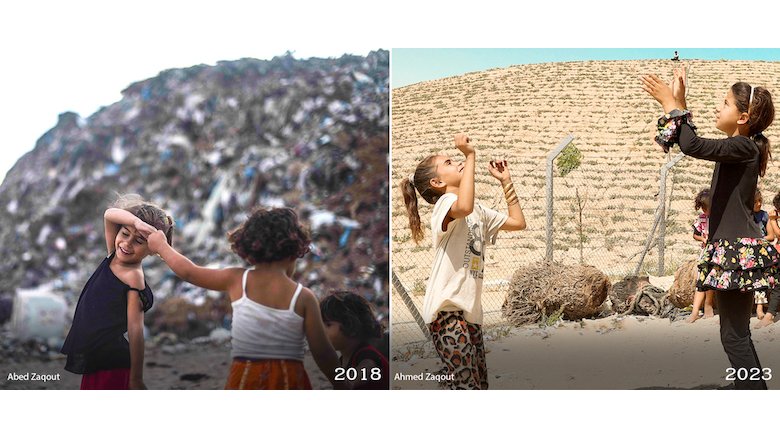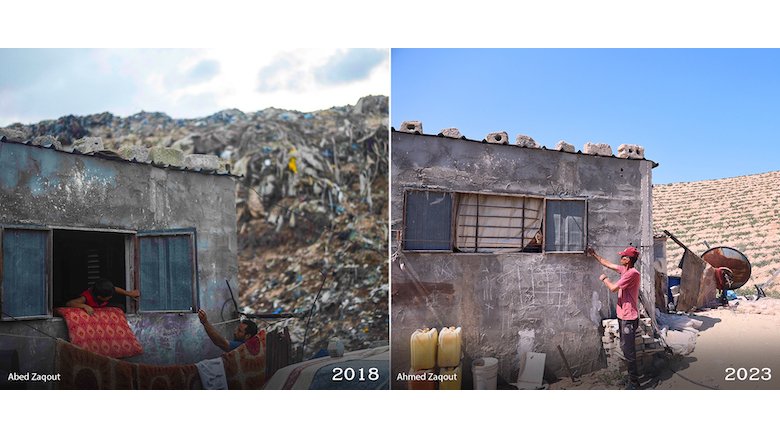The Gaza Solid Waste Management Project (GSWMP) has provided a critical solid waste management service to almost 1 million people in Southern and Middle Gaza. Prior to GSWMP, all waste generated in the area was disposed of at two saturated landfills and across several other smaller random dumpsites scattered across Gaza. The oversaturated Deir Al Balah and Sofa landfills, in addition to the proliferating dumpsites were creating environmental, health and social hazards for the inhabitants, negatively impacting quality of life in the area.
The US$32 million GSWMP project sponsored by the World Bank and donor partners1, intervened to solve the waste disposal problem in middle and southern Gaza by constructing the new Sofa Al Fukhari sanitary landfill, transfer stations, and a medical waste treatment facility, and rehabilitating three major dumpsites. The infrastructure improvements were further supplemented by capacity development support to the JSC-KRM (the solid waste service provider), which included the development of standard operating procedures (SOPs) for various solid waste functions and services and performance-based financial support focused on service improvements and cost recovery. Despite a very challenging and fragile context2 within which the project was located (one site was located within 50 meters of the Israel-Gaza border buffer zone), the project interventions culminated in significant improvements in secondary waste collection and disposal services in southern and middle Gaza, and beneficiary satisfaction reached a level of 89% at project end.
"Now, the landfill is operating in a neat and modern system and has known boundaries. The waste is buried and covered with a clay layer on a daily basis, which prevents the spread of flies and insects. Also, the landfill is closed at night to keep out waste pickers, and the tight fence around the landfill stopped the presence of stray dogs," Mr. Younis Al-Omour, a farmer near the town of Al-Fukhari.
While the project has multiple positive impacts, the most notable contributions relate to the following:
- Environmental Impact: The project contributed substantially to environmental mitigation, by helping to eliminate random dumping and unsanitary disposal of solid waste. Currently, 96% of waste generated in the project area is collected and disposed at the sanitary landfill, with an estimated 641,540 tons of waste diverted from dumping to sanitary disposal since the commissioning of the Sofa Al Fukhari sanitary landfill in 2019. Over the life of the landfill capacity, more than 2 million tons of solid waste will be taken care of in the first phase, which will have significant environmental benefits, including the prevention of leaching of pollutants into the groundwater, elimination of odor, stopping spontaneous fires and improvement of air quality, in addition to the rehabilitation of over 12.6 hectares of contaminated land in the project area.
- Climate Change Contributions: The sanitary disposal of waste, combined with the closure of major dumpsites at the Deir Al Balah and Old Sofa sites, is expected to further capture ~26,407 tons of methane emission, contributing to overall climate change mitigation measures.
- Health and Social Impact: Significant improvements have been noted to the health and well-being of residents due to reduction in waste burning, odor, pests, and stray dogs, which were causing prevalent respiratory and other illnesses. The now closed and rehabilitated Al Namsawi dumpsite, located in the most densely populated neighborhood of Gaza, was a growing health and safety hazard due to ongoing hazardous mixed-waste dumping and the risk of structural collapse.
- Cost recovery, cost savings and progress towards financial sustainability: Through successful application of a results-based incentive scheme provided by the Global Partnership for Results-Based Approaches (GPRBA), the project interventions enabled significant improvements in JSC-KRM cost recovery efforts, with cost recovery reaching 71% at project closure from a baseline of 15% at project start. Moreover, the average medical waste treatment cost was reduced from $2.87 per kg in 2018 to US$0.29/kg by 2022.
- Institutional and Capacity Building Support: The project pioneered a Waste Management Information System (WMIS), which has helped the Joint Service Council to monitor daily operations, identify and respond to hot spots, evaluate performance, and plan its service in a more efficient and effective manner.
- Integration of informal workers and job creation: The project supported 16 informal waste-pickers who received formal jobs. In addition, the project generated incremental temporary employment opportunities of about 40,000 person-days (133 person-years/annum) through the various project activities.
- Engaging with citizens through awareness campaigns: The project supported well-organized citizen engagement interventions, with the aim of raising awareness of the project and improving overall waste management practices. Several surveys found that the service satisfaction level among citizens improved from a baseline of 55% at project start to 89% by the project end.
"The Gaza Solid Waste Management Project has enabled a transformational shift in provision of services to the population despite the very fragile and constrained environment in Gaza. Such efforts need to be replicated as the Palestinian population continues to grow and solid waste remains a potential threat to public health unless it is safely and wisely managed," said Stefan Emblad, World Bank Country Director for the West Bank and Gaza.
The successful implementation of the project pointed to key lessons learned: i) coordination among actors and flexible and agile project design are two key ingredients for maintaining the focus on positive results for the target population in challenging and fragile contexts; ii) supplementing physical SWM interventions with institutional and capacity building (for example, standard operating procedures, waste management information system) reinforces sustainability of project results; iii) a results based funding schemes, with the right kind of incentives, can encourage the service provider to do more to support improvements in in identified areas, including quality of service and cost recovery; and iv) Interventions focusing on just one part of Solid Waste Management are not sufficient. Instead, a holistic integrated approach that tackles the entire Solid Waste value chain –waste generation-recovery/recycling-collection-transfer-disposal - provides a sound framework for sector-wide transformation.
Coordinated efforts by governmental agencies, development partners and citizens will be needed to transform the solid waste management sector, to avert environmental threats, contribute to climate change mitigation, and improve the living conditions and the well-being of the Palestinian people.
1 The World Bank funding (along with PID-MDTF and GPRBA TFs) is 13.25 million and other donor partners, who either co-funded or provided parallel financing include: French Development Agency, the European Union, Islamic Development Bank, UNDP
2 Three major escalations and frequent conflicts occurred during project implementation (2014-2022)


